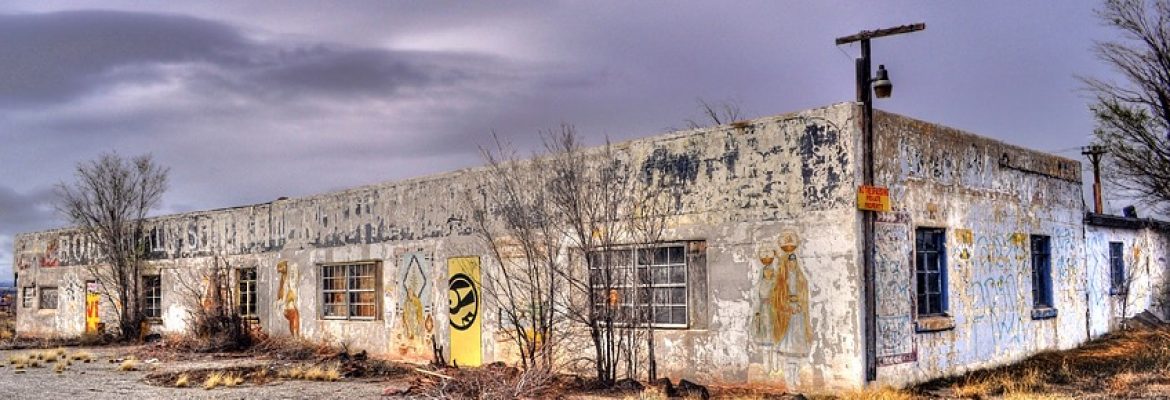Bowlin’s Old Crater Trading Post, Bluewater, New Mexico, USA
Located in the high, scrub desert north of Bluewater the Old Crater Trading Post stands as a quiet testimony to the booming trading post and curio shop industry that once lined the Route 66 roadside. Built in 1954, its stucco walls, viga beams, and flat roof are typical of vernacular construction in the Southwest. However, this building is distinguised for its connection to an enterprising family with a long trading post history, and also for its colorful, stylized murals that have caught the eye of travelers for more than half a century.
A walk along the façade today reveals a painting of an American Indian holding a hoop. Another plays a drum. A man rides horseback; a woman weaves a rug. Two girls walk with pots balanced on their heads. Above the paintings are several layers of painted advertising. Largely faded or superimposed over one another, some are still legible. “Jewelry,” says one, and “Rugs” another. “Bargains” and “Bowlin” can both be read along the south wing of the building, along with the Bowlin Company logo, a running Indian holding a tomahawk and wearing a headband and feather. Colorful and simplistic, the murals illustrate the way native peoples were commonly represented in tourist and popular mainstream culture.
Before the current Old Crater Trading Post was built in 1954, an earlier trading post stood in its place. Owner and operator Claude Bowlin built the original post in 1936, naming it for a nearby volcanic crater that had become a local tourist attraction. Bowlin had an extensive background in commercial trade, particularly with American Indians, and came from a long line of traders and merchants.
began his mercantile career in 1912 as an off-reservation trader in Gallup, on the southern periphery of the Navajo Reservation. The majority of Bowlin’s customers were Navajos. He quickly became the primary trader with the area Navajo population, dealing in commodities such as rugs, jewelry, sheep, and wool. Bowlin left the business to serve in World War I, but, by the 1920s, he was back in the trade. For more than a decade, he continued to develop a trusting relationship with Navajos, particularly artists. In 1936, he sold his interest in a trading company based in Gallup and built the Old Crater Trading Post on unpaved Route 66 just about a mile north of Bluewater.
Bowlin’s enterprise reflected the traditional trading posts of the late-19th and early-20th centuries. The grounds contained corrals, dipping vats, and shearing sheds. Inside, a pot-bellied stove warmed a pot of coffee, and a roof support post studded with nails held cups. Horse bridles, canned peaches, pants, and shawls were on the shelves. Claude Bowlin, whom the Navajo called Nahtsonahi or “Mouse,” was in his element.
In addition to being the local mercantile, the trading post became the center of community life for the surrounding Navajo population. The Bowlin family sponsored a number of activities such as chicken pulls, buckboard races, and card games. Claude Bowlin was well-respected among the Navajo, and likewise he held the Native Americans in high regard. When a local Navajo asked the Bowlins to raise his child so that he would become familiar with the white man’s world, Claude and his wife, Willa, agreed. Their “adopted” son, Tom, grew up to become the first Navajo elected to the New Mexico Senate.
By 1938, the entire length of Route 66 had pavement and traffic increased dramatically. The nature of Bowlin’s business began to change. Bowlin added gas pumps. He marketed Navajo dolls and souvenir moccasins to passing tourists and hired silversmiths and rug weavers to work at the trading post. Change was gradual at first, and most of Bowlin’s customers continued to be local Navajos. But during the years following World War II, tourism boomed and Bowlin’s focus shifted to accommodating travelers along Route 66. During the 1940s, he and other family members built three more stores in southern and eastern New Mexico. The chain of stores expanded further in the 1950s with two stores near Las Cruces and another north of Alamogordo.
In the face of a growing number of curio shops that often called themselves “trading posts,” Claude Bowlin sought to distinguish his stores as true to the ways of old-time traders. He continued to deal with area Native Americans and made a strong effort to educate passing tourists about tribal cultures. He hired artists from area reservations to work in his stores and he printed and distributed pamphlets that taught tourists how to identify authentic Navajo jewelry. Bowlin became a member of the United Indian Traders Association (UITA), which set standards for the creation of American Indian arts and crafts, and sold only UITA silverwork in his stores.
With the success of their chain of stores, the Bowlins decided to demolish the first Old Crater Trading Post and construct a new building on the site. The building that stands there today was completed in the spring of 1954.
Twenty years later, Interstate 40 was built across New Mexico, and Route 66 was largely abandoned. The Old Crater Trading Post closed in 1973. Claude Bowlin had been enjoying retirement for several years by that time. He died shortly after his trading post on Route 66 closed, and his widow, Willa, sold the property. The deed stipulated that the property be conveyed for religious purposes only. The building was home to the Bluewater Bible School and Church during the 1980s and 1990s, and was listed on the National Register of Historic Places in 2006.
Bowlin’s Old Crater Trading Post is at 7650 Old Route 66, which is now the frontage road for Interstate 40 one-and-a-half miles north of Bluewater, NM. The building is used to mount bill boards, and the interior is not accessible.


